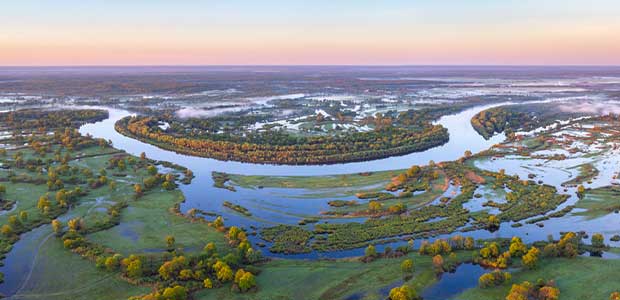
How to Prepare Floodplains for Climate Change
With flooding expected to increase if action isn't taken, it's vital we act now.
- By Jane Marsh
- Apr 21, 2023
When considering the implications of climate change, you may wonder why someone would choose to live in a floodplain. However, people have called floodplains home for centuries. Enticed by recreational opportunities, fertile agricultural land and nearby water resources, the appeal should be no surprise.
Yet, residents face severe damage to their homes and livelihoods when the rivers flood. As extreme weather events grow more frequent and intense, preparations become necessary.
Worst Flooding Event in America
The Great Flood of 1927 occurred in the Mississippi River and became recognized as the worst flooding event in U.S. history. Rushing water saturated 27,000 square miles—approximately the size of New England—killing nearly 1,000 people and displacing 700,000 more.
The Great Flood cost nearly $1 billion in damages and required the entire National Guard aircraft fleet to assist with rescue operations.
Following 17 inches of rainfall in the Pearl River in 1983, the second most severe flood of the Mississippi destroyed 700 homes and led to 2,500 people evacuating the area.
Events like these Mississippi River floods are bound to worsen in the coming years. Just as the 1983 flood prompted calls for levees, today’s experts quickly seek strategic mitigation for floodplains.
The Floodplains at High Risk of Disaster
According to satellite data from NASA, 24 percent of the global population is exposed to flooding disasters. Scientists found that 58 to 86 million people now live in flood-prone areas worldwide, while 255 million people experienced at least one flooding between 2000 and 2015.
Calculations predict that 102,225 properties have a 26 percent higher risk of severe flooding in the next 30 years in New York City—nearly 17 percent of all properties. More recently, Fort Lauderdale, Florida, saw over 20 inches of rain in six hours, sending a stream of water down roadways and shutting down businesses, schools and the airport.
Scientists predict that U.S. flooding events will rise by 26 percent by 2050 if we fail to get climate change under control. Damages could also run nearly $32.1 billion as communities struggle to repair their homes and businesses.
5 Climate Strategies for Floodplains
Fortunately, climatologists aren’t sitting down on the job—strategic planning is underway to develop viable solutions against climate disasters in floodplains. As more people move to floodplain regions, protecting them and their communities is essential.
1. Develop comprehensive management. A comprehensive management plan for floodplains assesses the risks and sets measurable goals to mitigate extreme weather effects. Outlining the procedures—including preservation, resilience planning and emergency response—allows residents and various organizations to better prepare for disaster and minimize the outcome.
2. Generate emergency preparedness. Emergency preparedness is a crucial component of floodplain mitigation—creating protocols should follow a risk assessment. For instance, people may have a split second to save themselves during flash flooding. An emergency preparedness plan outlines evacuation routes using road maps of the closest streets to main roadways.
Other emergency planning could include pinpointing alternative energy sources in case of power outages, determining the equipment needed to protect infrastructure and implementing an ongoing training program for rescuers.
3. Upgrade dams. Climate change has demonstrated its mercilessness and crumbling infrastructure risks greater devastation to an area. For example, older levees and other water-resisting structures can break, allowing large quantities of water to inundate a floodplain.
The American Society of Civil Engineers says it would cost a total of $113.6 billion to upgrade U.S. dams—about $20 billion of that would go toward the 2,300 high-hazard dams. Meanwhile, U.S. dams are roughly 57 years old. It’s time to invest where it counts the most.
4. Utilize natural mitigation. Engineered solutions for floodplain management are only so efficient—that’s why it’s crucial to implement natural solutions, too.
Protecting wetlands can slow down and store water flow, preventing construction in open spaces like parks, decreasing coastal erosion and building up vegetation to the shoreline are all approaches we can take.
5. Learn from history. Of course, we should pay attention to lessons from historical flood events. History shows floodplain residents suffered great devastation due to poor planning and organization.
Ignoring climate change isn’t going to stop it from bearing down on vulnerable communities—a reason why building climate-resilient areas is essential. Residents, governments, businesses and stakeholders must work together to implement floodplain mitigation and protect their futures.
The Time Is Now to Address Future Flooding
It’s impossible to put off developing solutions for floodplains as climate change becomes increasingly unavoidable. Extreme and unexpected weather patterns pose too much risk for those living in floodplains, their communities and the economy. Generating a plan to offset the damages will become dire in the coming years.
About the Author
Jane Marsh is an environmental writer. You can keep up with her work on her site Environment.co.